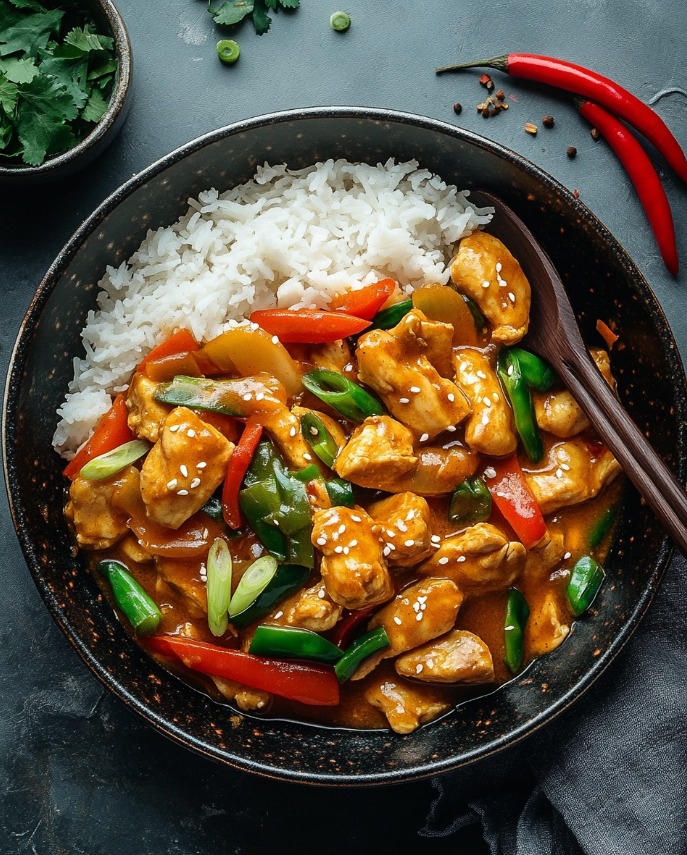Why This Chinese Curry Chicken Recipe Will Make Your Kitchen Smell Amazing
There’s something magical about the smell of curry wafting through the house. It’s warm, inviting, and makes everyone flock to the kitchen like moths to a flame. I first tried making this Chinese Curry Chicken on a lazy Sunday afternoon when my family was craving takeout but didn’t want to leave the house. Spoiler alert: it turned out better than any restaurant version we’d had before! Packed with tender chicken, crunchy veggies, and a vibrant yellow curry sauce, this dish is a crowd-pleaser that’s easy enough for a weeknight yet impressive enough for guests.
A Little History Behind Chinese Curry Chicken
You might be wondering, “Isn’t curry more of an Indian thing?” Well, yes and no. While curry originated in India, its flavors traveled across Asia and got reimagined in countless ways. In China, curry took on a milder, sweeter profile, often served with rice or noodles. This Chinese Curry Chicken recipe reflects that balance—rich and aromatic without being overwhelming. It’s become a staple in Asian home cooking, especially for those who love bold flavors without too much heat. Fun fact: the curry powder used here is often inspired by Japanese blends, which are smoother and less spicy than their Indian counterparts.
Why You’ll Love This Recipe
This dish is all about simplicity meeting big flavor. The prep is quick, the ingredients are pantry-friendly, and the results? Restaurant-quality! Plus, it’s naturally gluten-free if you use tamari instead of soy sauce. Whether you’re a seasoned cook or a beginner, this recipe will make you feel like a rockstar in the kitchen. And let’s not forget how versatile it is—you can tweak the spice level, swap veggies, or even add tofu for a vegetarian twist. Trust me, once you try it, you’ll want to make it again and again.
Perfect Occasions to Whip Up This Dish
This Chinese Curry Chicken is perfect for busy weeknights when you need something fast but satisfying. It’s also great for dinner parties because it looks fancy but doesn’t require hours of work. Hosting a potluck? Bring this along—it pairs beautifully with steamed rice or noodles. And if you’re trying to impress someone (wink wink), this dish will do the trick. The vibrant colors and mouthwatering aroma speak for themselves.
Ingredients You’ll Need
- For the chicken:
- 12 oz / 340 g chicken breast, thinly sliced against the grain
- 1/4 teaspoon salt
- 1 tablespoon dry sherry (or substitute with rice wine)
- 1 tablespoon cornstarch
- For the spice mix:
- 1 1/2 teaspoons curry powder (Japanese S&B or Madras works well)
- 1 teaspoon turmeric
- 1/4 to 1/2 teaspoon red pepper flakes (optional, adjust to taste)
- For the stir-fry:
- 2 tablespoons peanut or vegetable oil
- 1/2 large white onion, chopped
- 1-inch piece of fresh ginger, finely minced
- 1 green bell pepper, cut into bite-sized pieces
- 1 carrot, thinly sliced
- 1 cup low-sodium chicken broth
- 2 teaspoons sugar
- 1 teaspoon salt
- 2 teaspoons oyster sauce
Substitutions and Swaps
No chicken on hand? Swap it with shrimp, beef, or even tofu for a plant-based option. If you’re out of dry sherry, mirin or a splash of white wine works too. For a gluten-free version, ensure your oyster sauce is labeled gluten-free or use tamari instead. Don’t have fresh ginger? A pinch of ground ginger can save the day, though fresh is always best. Feel free to mix up the veggies—snap peas, broccoli, or zucchini would all shine here.
Step 1: Marinate the Chicken
Start by slicing your chicken breast into thin strips. Toss them in a bowl with salt, dry sherry, and cornstarch until they’re evenly coated. Let the chicken hang out while you prep the rest. This quick marinade locks in moisture and gives the chicken a velvety texture. Pro tip: Slice the chicken against the grain for maximum tenderness. Nobody likes chewy chicken!
Step 2: Cook the Vegetables
Heat your oil in a large skillet over medium-high heat. Add the onions and let them sizzle for about a minute—they should soften slightly but still have some crunch. Onions are the unsung heroes here, adding sweetness and depth to the dish. Keep an eye on them; burned onions are nobody’s friend.
Step 3: Add Spices and Veggies
Next, toss in the ginger, bell pepper, and carrots, followed by the curry powder, turmeric, and red pepper flakes. Stir everything together until the spices release their fragrance—your kitchen will smell incredible at this point. The veggies should stay crisp-tender, so don’t overcook them. Imagine biting into a perfectly cooked carrot slice: it should squeak just a little between your teeth.
Step 4: Make the Sauce
Pour in the chicken broth, sugar, salt, and oyster sauce. Stir well and bring the mixture to a gentle boil. The sauce will start to thicken slightly as the cornstarch from the chicken marinade does its magic. Taste as you go—you might want to adjust the seasoning depending on your preferences. Remember, the sauce is the heart of this dish, so take your time here.
Step 5: Cook the Chicken
Reduce the heat to medium-low and gently add the marinated chicken to the pan. Use a spatula to separate the pieces if they stick together. Let the chicken simmer for about 2 minutes, just until it’s cooked through. Overcooking will make the chicken tough, so keep an eye on it. As the chicken cooks, the sauce will continue to thicken, creating a glossy coating around every piece.
Step 6: Serve and Enjoy
Transfer your masterpiece to a serving platter and dig in! Serve it hot alongside steamed rice or noodles. Garnish with a sprinkle of chopped green onions or sesame seeds for extra flair. The combination of tender chicken, crunchy veggies, and that luscious curry sauce is pure comfort food.
Chef’s Secret
Here’s a little secret: let the dish sit for 2–3 minutes after cooking. This resting time allows the flavors to meld together and the sauce to thicken slightly. Patience pays off!
Tips and Tricks
When slicing the chicken, aim for uniform pieces so they cook evenly. Always preheat your pan before adding oil—it prevents sticking and ensures a good sear. If you’re unsure about spice levels, start with 1/4 teaspoon of red pepper flakes and adjust later. Lastly, don’t skip the fresh ginger—it adds a zingy kick that dried ginger just can’t replicate.
How to Store Leftovers
Store leftover Chinese Curry Chicken in an airtight container in the fridge for up to 3 days. Reheat gently on the stovetop with a splash of water to loosen the sauce. Freezing is possible but may alter the texture of the veggies, so consume fresh if you can.
If you plan to freeze, portion the dish into individual servings before freezing. This way, you can thaw only what you need. Thaw overnight in the fridge and reheat slowly to preserve the flavors.
For meal prep enthusiasts, this dish is a dream. Divide it into containers with rice or noodles for grab-and-go lunches. Just microwave and enjoy!
Presentation Ideas
- Garnish with toasted sesame seeds or chopped cilantro for color contrast.
- Serve in a shallow bowl with a side of crispy wonton strips for crunch.
- Use a ring mold to shape the rice neatly on the plate for a restaurant-worthy look.
Healthier Variations
Want to lighten things up? Try these swaps:
- Low-Sodium Version: Use homemade stock instead of store-bought broth and reduce added salt.
- Vegan Option: Replace chicken with tofu and use a vegan oyster sauce alternative.
- Low-Carb Twist: Serve over cauliflower rice instead of regular rice.
- Spice-Free: Skip the red pepper flakes entirely for a mild curry.
- Extra Veggies: Double the amount of vegetables for a nutrient boost.
- Coconut Milk Base: Add a splash of coconut milk for creaminess without heaviness.
Mistake 1: Overcrowding the Pan
One common mistake is piling too much chicken into the pan at once. This lowers the temperature and causes the chicken to steam instead of sear. To avoid this, cook in batches if needed. A crowded pan means soggy chicken, and nobody wants that.
Mistake 2: Skipping the Resting Time
Rushing to eat immediately after cooking is tempting, but letting the dish rest for a few minutes helps the flavors develop fully. Think of it as letting a fine wine breathe—it’s worth the wait.
Mistake 3: Using Old Spices
Spices lose potency over time, so check the expiration dates on your curry powder and turmeric. Fresh spices make a world of difference in flavor.
Frequently Asked Questions
Can I use chicken thighs instead of breasts?
Absolutely! Chicken thighs are juicier and more forgiving if slightly overcooked. Just trim excess fat and slice them thinly like the breasts.
What type of curry powder should I use?
Japanese S&B curry powder or Madras curry powder works beautifully. Both are mild and complement the dish’s sweetness.
Is this dish kid-friendly?
Yes! Simply omit the red pepper flakes or reduce the amount to suit younger palates. Kids love the creamy sauce and tender chicken.
Can I make this ahead of time?
Definitely. Prepare the components separately and combine them just before reheating. This keeps the veggies crisp and the sauce smooth.
How do I prevent the sauce from being too thick?
Add a bit more chicken broth during cooking. Remember, the sauce thickens as it cools, so err on the thinner side initially.
What sides pair well with this dish?
Steamed jasmine rice, egg noodles, or even quinoa are excellent choices. A simple cucumber salad adds freshness to balance the richness.
Can I double the recipe?
Of course! Just ensure your pan is large enough to accommodate the increased volume. Otherwise, cook in two batches.
What if I don’t have oyster sauce?
Substitute with hoisin sauce or a mix of soy sauce and a touch of honey for sweetness.
How spicy is this dish?
The spice level is customizable. Start with 1/4 teaspoon of red pepper flakes and increase gradually based on your tolerance.
Can I use frozen vegetables?
Yes, but thaw and pat them dry first to avoid diluting the sauce with excess moisture.
Final Thoughts
There’s nothing quite like the satisfaction of recreating a beloved takeout dish at home—and this Chinese Curry Chicken nails it. With minimal effort, you get maximum flavor, making it a go-to recipe for busy nights or special occasions alike. So roll up your sleeves, grab your apron, and give this one a try. Your taste buds (and your wallet) will thank you!

Chinese Curry Chicken
Ingredients
Equipment
Method
- Slice the chicken breast into thin strips and toss with salt, dry sherry, and cornstarch; let marinate.
- Heat oil in a large skillet over medium-high heat; add onions and sauté for about a minute until softened.
- Add ginger, bell pepper, and carrots; stir in curry powder, turmeric, and red pepper flakes; cook until fragrant.
- Pour in chicken broth, sugar, salt, and oyster sauce; stir, bringing to a gentle boil until slightly thickened.
- Add marinated chicken, simmer for about 2 minutes until cooked through; ensure not to overcook.
- Serve hot, garnished with green onions or sesame seeds, alongside steamed rice or noodles.
